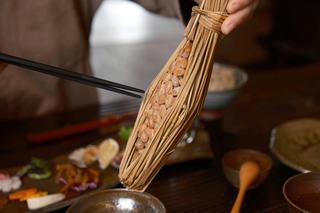Lugaw, Congee, Goto and Arroz Caldo - What's the Difference?

The Philippines is a rice-loving nation and with the territory comes a million different dishes made and eaten with rice. Between lugaw, goto, arroz caldo, and congee, we’re spoilt for choice when it comes to delicious bowls of rice porridge. But did you know that the average Filipino doesn’t even know the difference between lugaw, goto, arroz caldo, and congee? If you’re confused like everyone else, you’ve come to the right spot! We’re here to dispel any confusion about these Filipino porridges and finally end your Google search of goto vs porridge vs rice broth vs every rice-based comfort food you can think of.
All of these dishes (lugaw, goto, arroz caldo, and congee) share so many things in common that we completely understand the confusion. All of these dishes have their base made of rice, usually malagkit or sticky rice. In terms of cooking, these rice porridges require a long simmer time to get that gelatinous texture that we’ve all come to love. Since the base is so similar, the way to tell these rice dishes apart is through their mix-ins. Some are plain while others have different mix-ins like ox tripe, chicken, and even century egg.
Lugaw
Lugaw is typically what Filipinos call every other savory rice porridge dish out there. In the simplest terms, lugaw is the base. It’s made with rice or glutinous rice that’s boiled and simmered in water for a long period of time to get that satisfying texture. It’s typically flavored with chicken cubes, ginger, and fish sauce. To finish it off, Lugaw is usually topped with toasted garlic, spring onions, and sometimes if you’re feeling fancy, an egg. If you really want to elevate your humble lugaw, add a few drops of Knorr Liquid Seasoning Original to your lugaw.
Because of the simplicity of this dish, it’s important to get the flavors right. We recommend trying this simple yet tasty Lugaw Recipe that uses Knorr Chicken Cube for that intense chicken flavor that’s equivalent to 1 kilo of meat. A budget-friendly recipe that doesn’t scrimp on taste! For something different, you can also try this Lugaw at Tokwa Recipe that recreates the flavors of pulutan favorite tokwa’t baboy in the form of rice porridge.
Congee
Congee is where it can, admittedly, get a bit more confusing since lugaw and congee essentially have the same base of rice and water with toppings. However, congee is the more globally known between the two.
Basically, congee is the Chinese version of lugaw, but the key difference is the toppings. There is more variety when it comes to congee.
While lugaw has very few toppings and is designed to be easy to digest (for those sick days), congee has more toppings that lean toward Chinese flavors. Typical congee toppings include century eggs, quail eggs, dumplings, tofu, and the usual meats of pork and beef. The meats and veggies tend to be more tender in congee compared to lugaw. That’s why congee is a much more filling and more flavorful rice porridge vs. lugaw. In short, congee is lugaw, but with a distinctly Chinese flair.
For an easy foray into the world of congee, try this easy Pork Congee Recipe that’s perfect for those rainy days.
Goto
Goto is a popular rice porridge that is similar to lugaw in its base but is made richer with the use of ox tripe. Goto means ox tripe and it’s this key ingredient that sets apart this rice porridge dish from lugaw, congee, and arroz caldo. On top of ox tripe, also known locally as tuwalya, goto also can have beef innards, beef, and pork mixed in for a heartier dish. Similar to lugaw, people eat goto with quite a few toppings as well such as toasted garlic, spring onions, egg, and chicharon bits for an extra indulgent touch.
A tip when making goto is to ensure that your ox tripe has been properly cleaned. It usually is sold clean in supermarkets but if not, you can clean it by simply boiling it completely submerged in salted water for 15 minutes. Afterward, simply scrape the tripe with a knife to remove any unsightly things that may be stuck to the tripe. It’s that simple.
Arroz Caldo
Arroz caldo is a dish that originated from congee and has since been renamed by the Spanish. The term itself translates to rice broth but don’t be fooled, arroz caldo comes in a variety of consistecies from thick to soupy. The main difference in this dish is the use of chicken and ginger in the mix. In fact, one of the key differentiators of arroz caldo is the strong ginger flavor that shines through the dish. There are plenty of ways that people make arroz caldo and some use kasubha (safflower) which gives it an appetizing yellow tinge. Since it’s already so filling, people don’t typically eat it with toppings but when they do, the toppings are similar to what is used on lugaw.
If reading this is already making your mouth water, try this classic Chicken Arroz Caldo recipe. If you’re looking for something meat-free, you can also try this Tokwa Arroz Caldo recipe. Both these recipes are infused with a rich taste of chicken all thanks to Knorr Chicken Cube.
With the rainy season in full swing, you can now easily satisfy your cravings for a warm bowl of rice porridge in the comfort of your own home. Whether you love lugaw, congee, goto, or arroz caldo, make sure to stock up on Knorr Cubes so that your rice porridge can have that rich and intense meaty flavor with minimal effort. What are you waiting for? Try making one of these recipes for dinner this week!
Suggested Article

Japanese Natto: A Quick Guide
